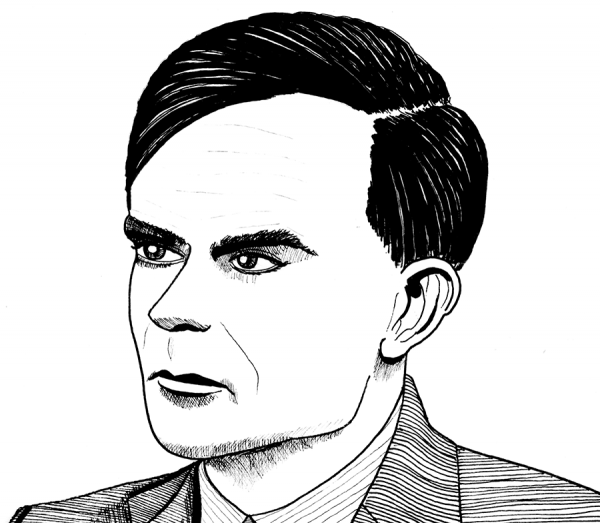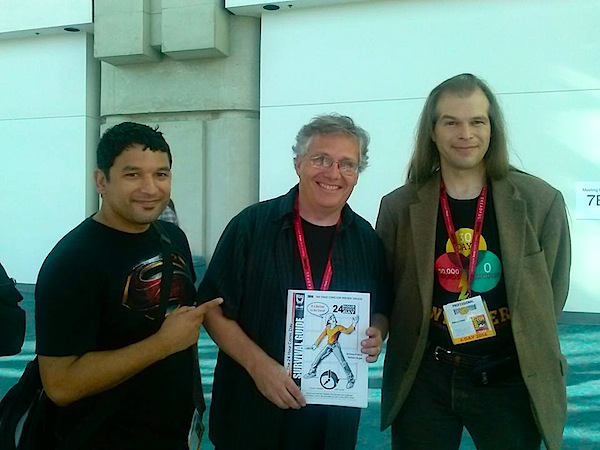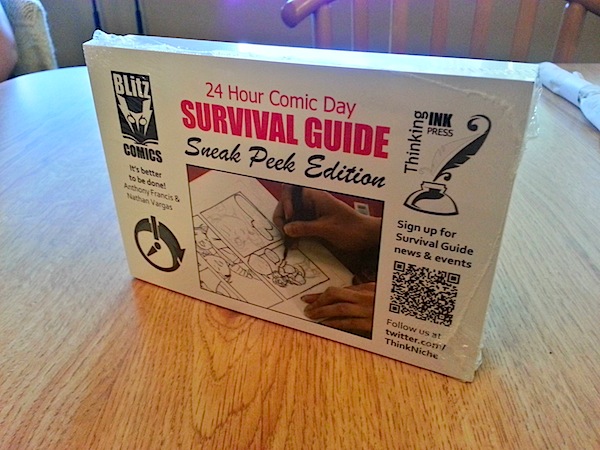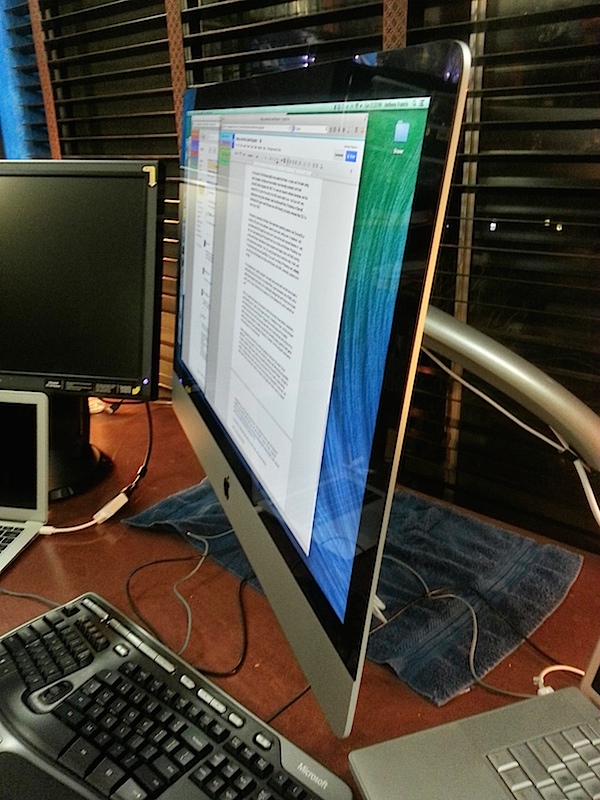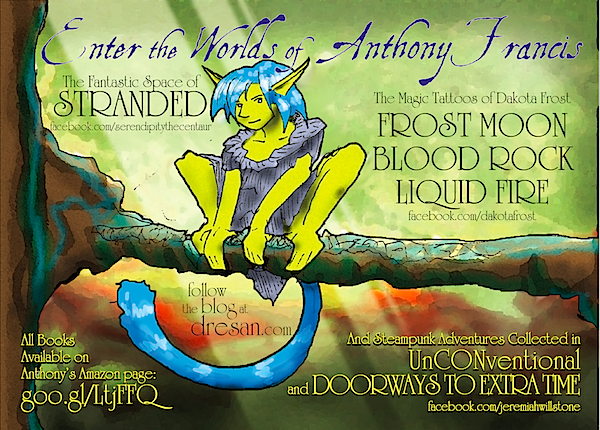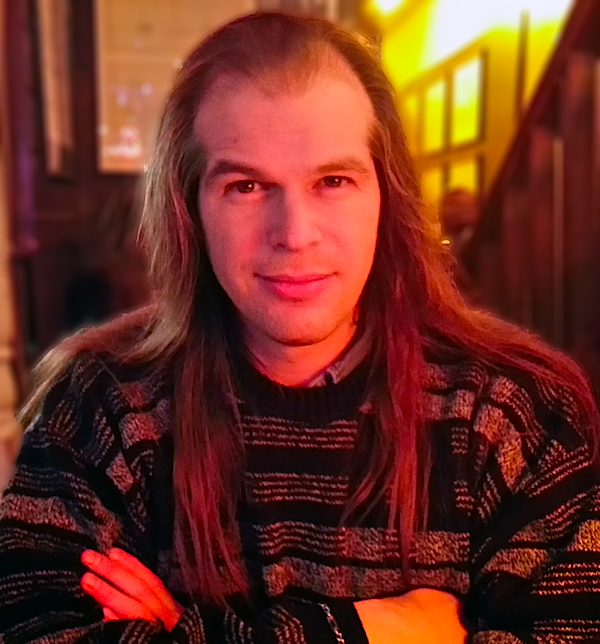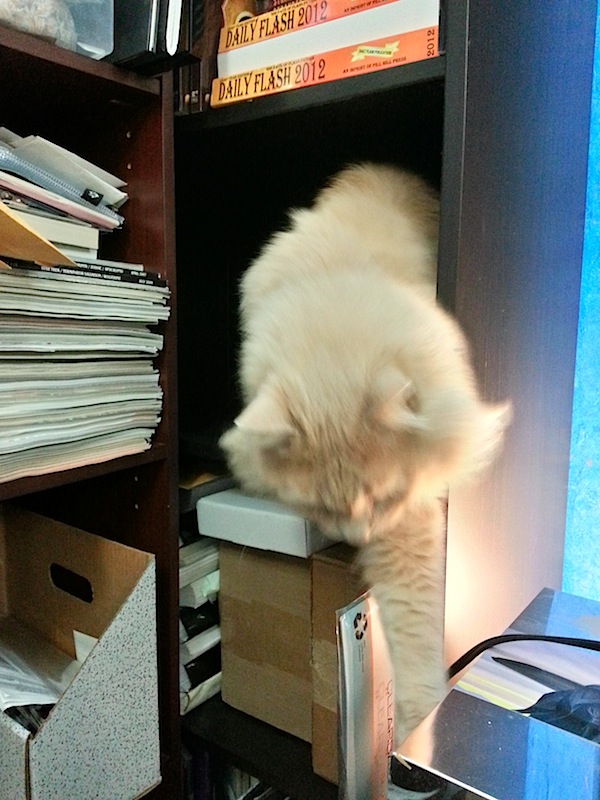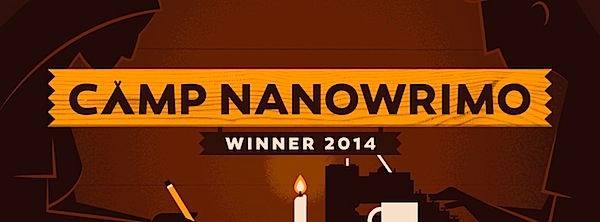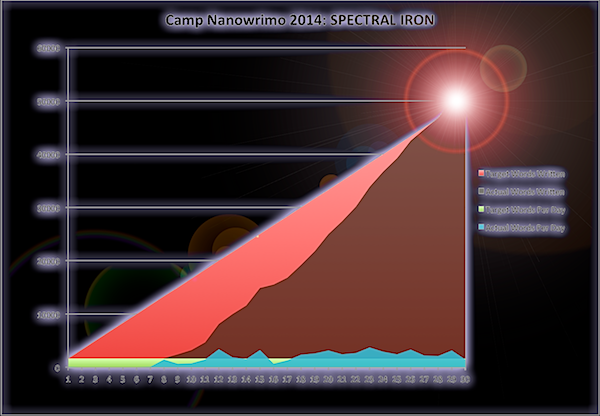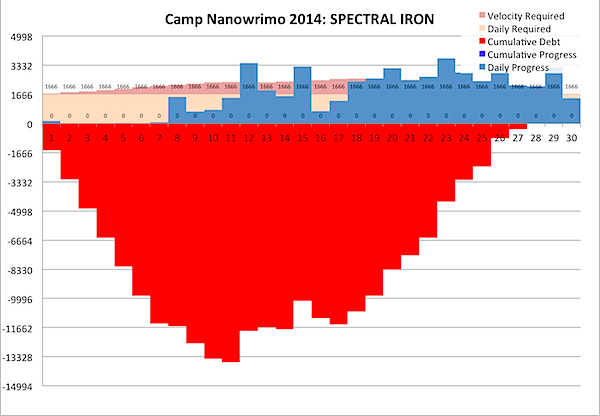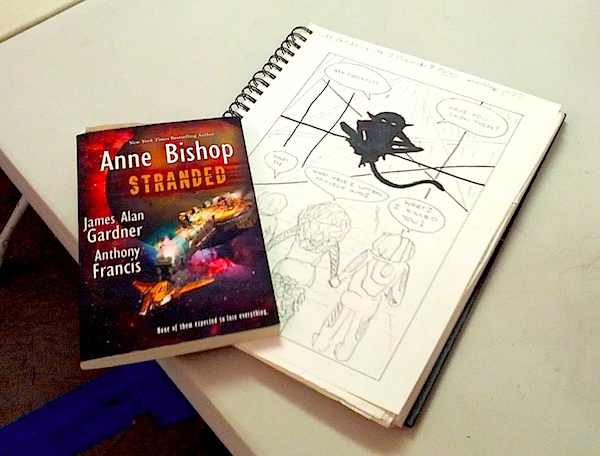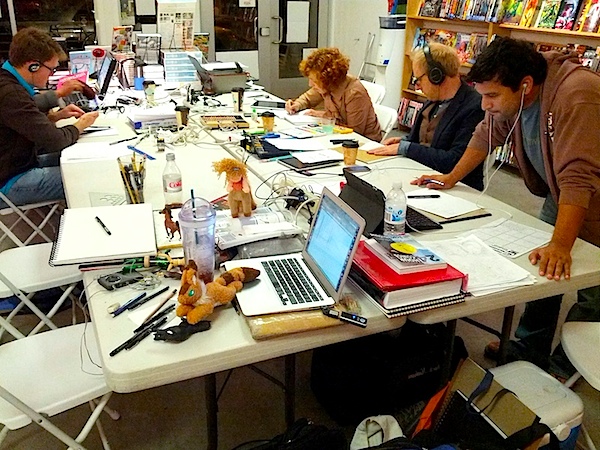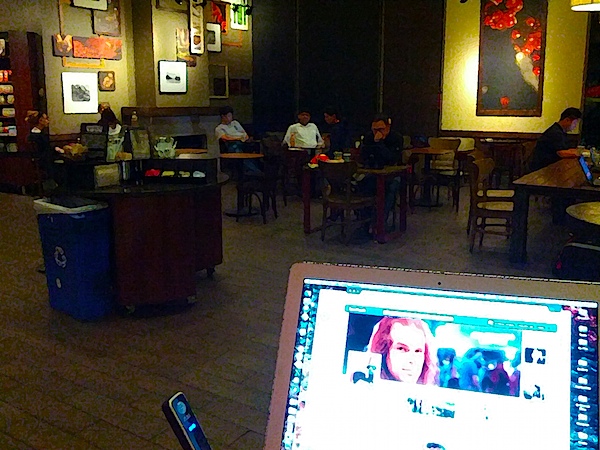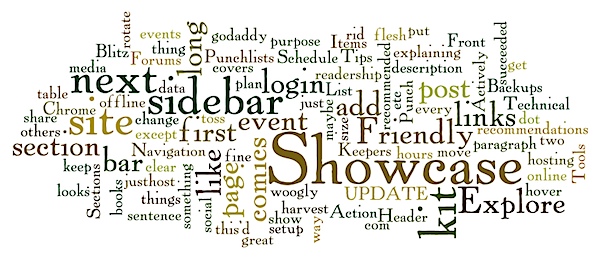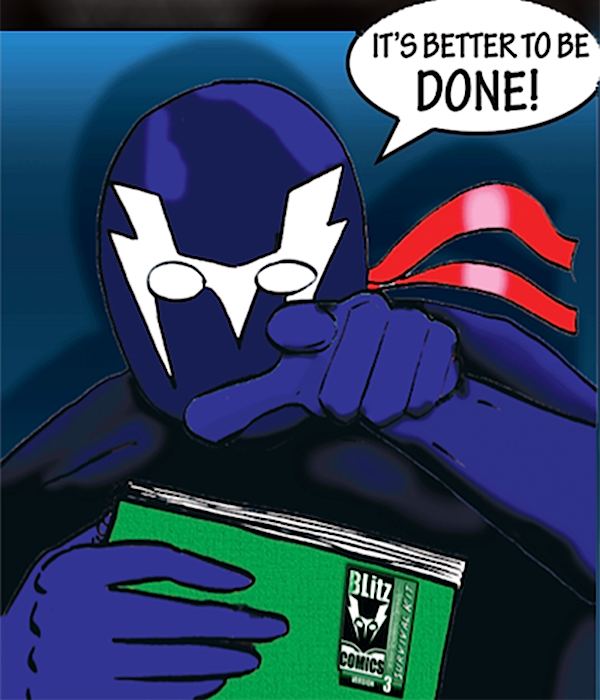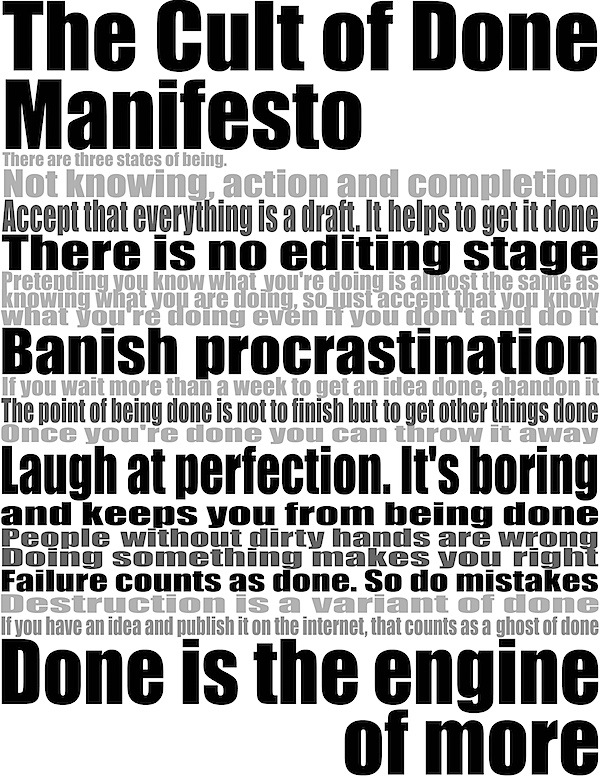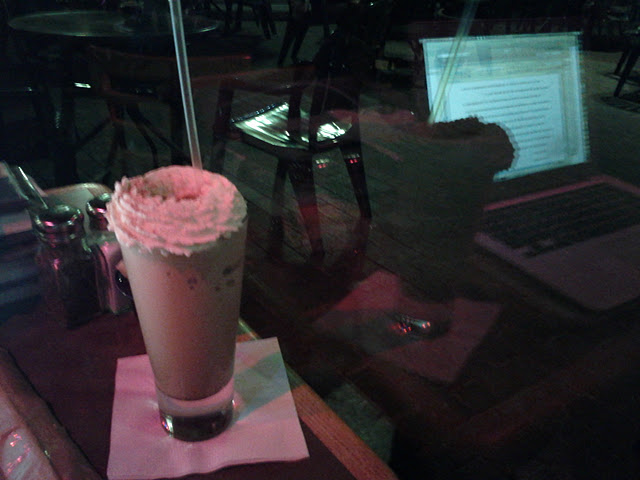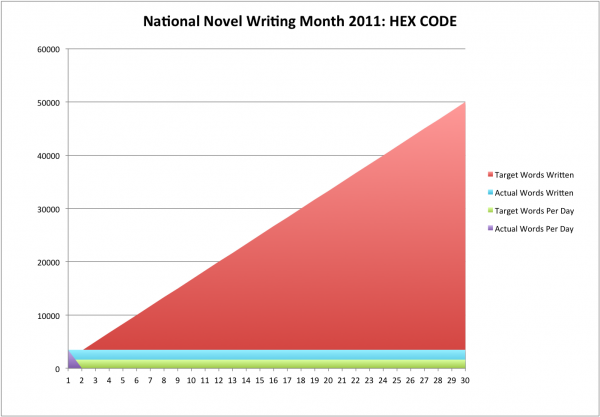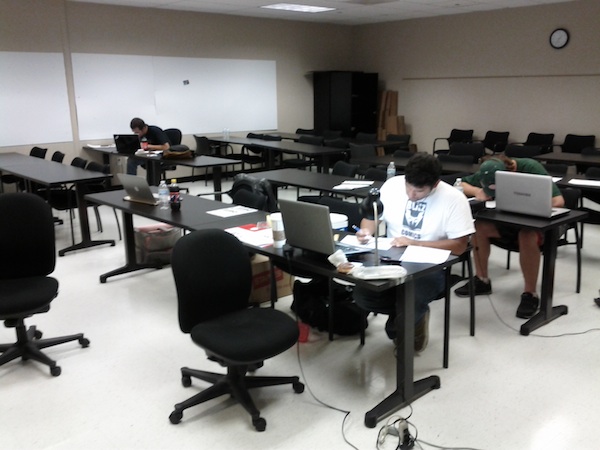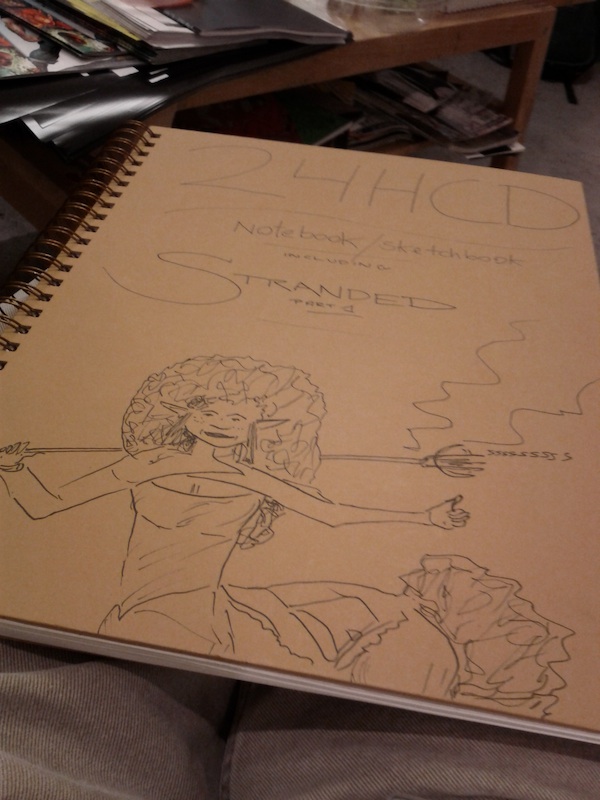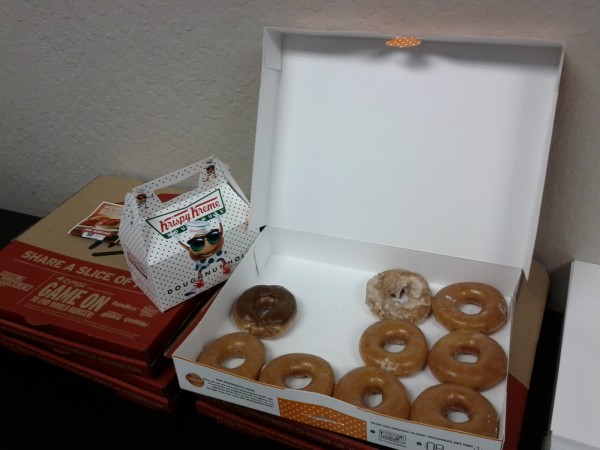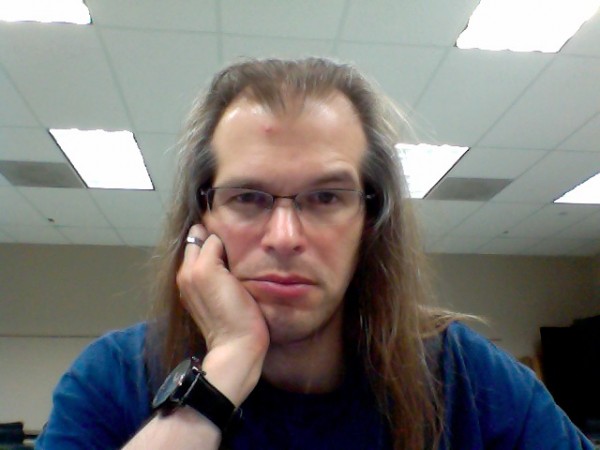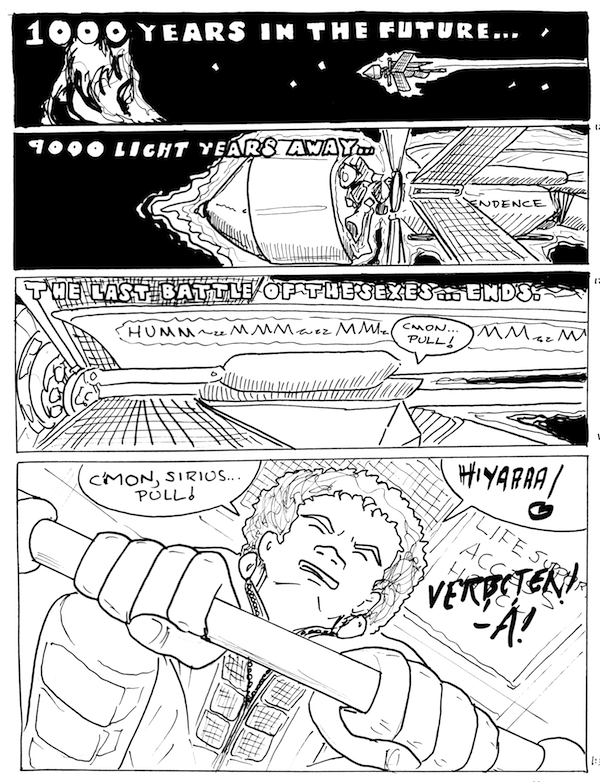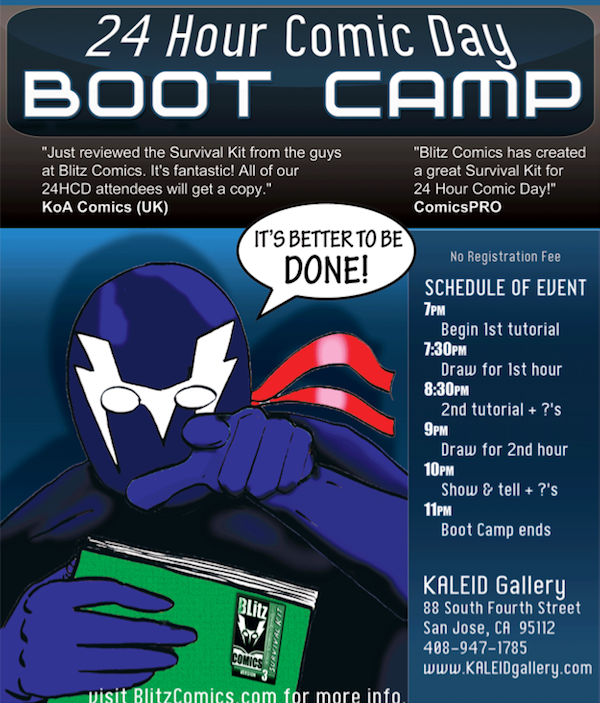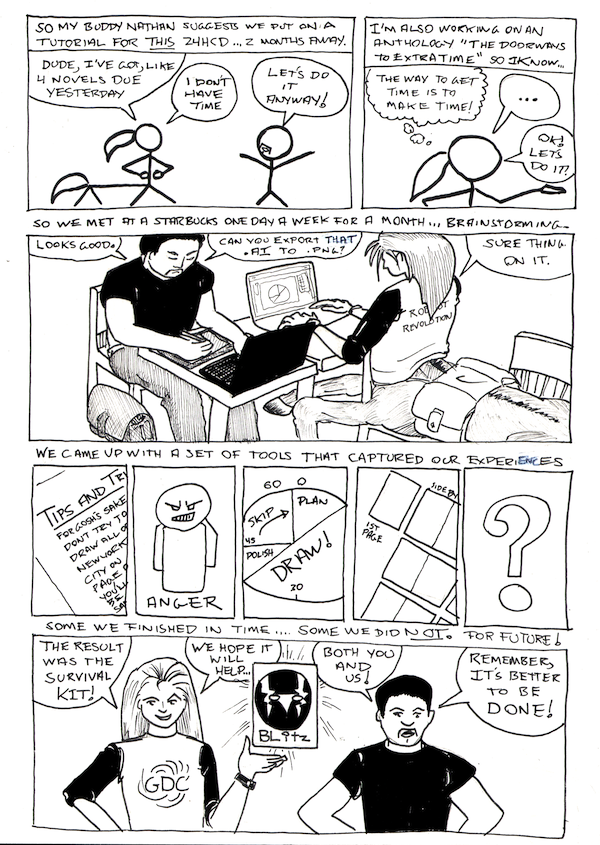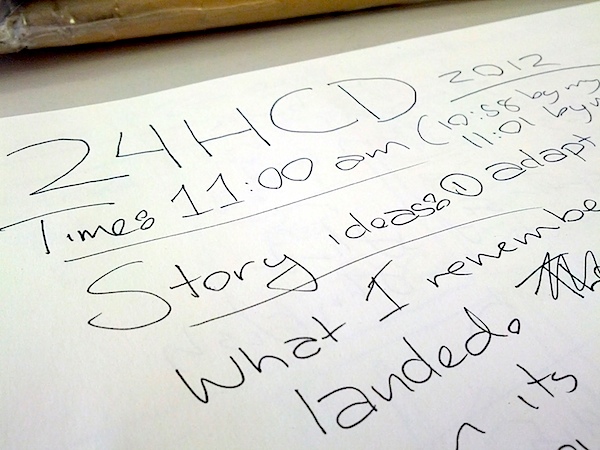
So another 24 Hour Comics Day has come and gone ... my fourth. I'd love to say it gets easier, and in a sense it does, but churning out 24 pages of a comic in just 24 hours is daunting, even if you've done it before. To help ourselves improve, my buddy Nathan Vargas and I put a lot of thought into what goes in to making the challenge a success and collect that at the site Blitz Comics.
To give a flavor of the experience, here's a timeline of my 24 Hour Comics day this year. Like last year, there are highs, there are lows, there are moments of triumph and despair, of hard work overcoming challenges - and experiences which are simply bizarre. Last year actually was more bizarre than this year ... but there were still a few dark hours near the hour of the wolf.
Before the event
T-minus 1 Year: Finish 24HCD successfully. Attribute success to a combination of the Blitz Comics Survival Kit and more life drawing classes, as I went from 7 pages done in 2010 to 24 pages done handily in 2011. Hooray! Resolve to improve Blitz Comics and take more life drawing practice.
T-minus 6 months: Remember we waited to last minute to prepare for 24HCD. Send message "Blitz Comics Lives" and begin planning to update our kit. Get overly ambitious, then scale it back as Nathan's booked up with work and Anthony's booked up with writing.
T-minus 3 months: Finish point update of Blitz Comics Survival Kit. (As of today, full versions are not posted everywhere due to some miscommunications and site storage issues, but we're working on it). Plan on giving another Blitz Comics tutorial, this time at Mission Comics. Other venues considered, but, man, Mission Comics .
T-minus 2 months: Give Blitz Comics Tutorial. Due to a publicity gaffe on our part, no-one shows up except a couple of friends, who leave before it begins. Decide to hold the tutorial anyway for practice. No-one attends but a beautiful and bizarre looking chicken; chicken's owner says our talk is fascinating. Really, I can't make this stuff up.
I'm not kidding here about the chicken. Photos or it didn't happen?
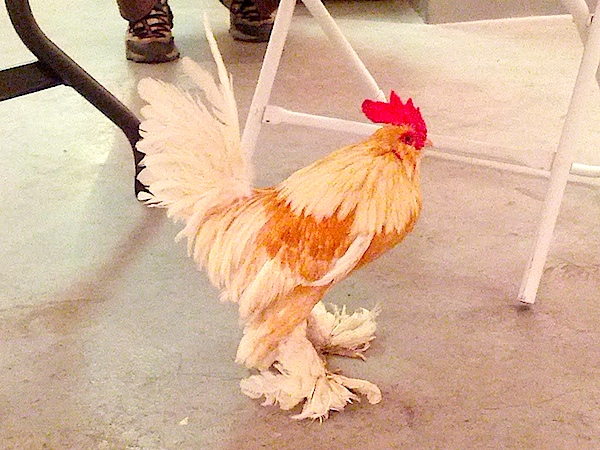
Oh, it happened. After the tutorial, back to preparation...
T-minus 1 month: Hold weekly "just drawing" parties where we mostly chew the fat about life, plan the event, and get in a few minutes' worth of drawing all at the end. Surprisingly, this really works. Get ready fo the event proper, agreeing to bring donuts and art supplies to Mission Comics. Oh, and sign up for space at Mission Comics event!
T-minus 1 week: Buy art supplies, both for ourselves and a large amount of free stuff to give to people at the event. Gather extras of the Survival Kit; make sure I can find all of last year's materials. Coordinate with Leef of Mission Comics to make sure we're confirmed and on the same page with Blitz Comics sponsoring event. Scope out parking garages for the event (fortuitously, I right up the street for a different event) and enter in GPS.
T-minus 3 days: Last "just draw" meeting. Confirm schedule for Saturday morning, which will include breakfast, donuts and helping Leef set up before the actual event. Draw up TODO and shopping lists. Draw some more.
T-minus 2 days: Last trip to the store since Friday will be booked up. Last minute art practice.
T-minus 18 hours: Last minute art practice and reading. Bail early on normal Friday night dinner-coffee-bookstore run in favor of going home to get everything ready.
T-minus 12 hours: Dig through post-novel-writing mess to find art materials. Wonder what I've gotten myself into. Find most of the materials, but decide to crash super early to make sure I'm awake for event.
T-minus 4.5 hours: Up at 5:30 and packing stuff up. I am king of the pile people, and the tote bag is my emblem.
T-minus 3 hours: Depart for event. Pick up Nathan, go for breakfast. My meal is up before Nathan's finished ordering, which is weird. Chill out, discuss what we're doing and why we're doing it, conclude that we're both crazy, but we're doing it anyway.
T-minus 2 hours: Leave breakfast, go pick up donuts for participants. Krispy Kreme FTW! One box regular, one box mixed (with an extra chocolate glazed for me). By the time we're done the time's now 9:30ish. Head to San Francisco, by this point almost an hour drive. Traffic is smooth and we've got lots of buffer.
T-minus 45 minutes: Arrival in San Francisco. Park, gather stuff, head to event. Nathan reroutes us from the shortest path to a nearby street which "has better energy;" this street proves to have a row of beautiful homes rather than backdoors and garbage cans, so, yes, indeed, it had better energy for walking up to the event.
T-minus 30 minutes: Arrive at Mission Comics. Set up. Because we're so early, Nathan and I get primo spots near Leef's desk (and the bathroom) but still in the front room. Chitchat. Notice first page of notebook has some damage on it and draw a "Cover Page" on the presumption that I'm going to adapt the second part of "Stranded". Get ready.
Yes, it is STARTING!
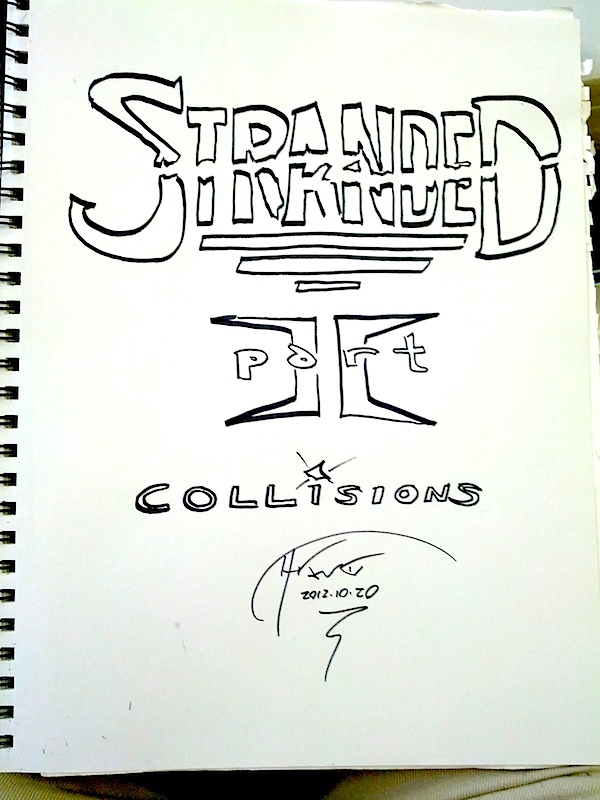
That page doesn't count towards my 24. Alright ... ready ... GO!
24 Hour Comic Day Begins
11:00AM October 20th Leef says "Go!" and I start reviewing my story ideas. I'm planning on adapting part 2 of "Stranded," picking up where I left off last year, but in the spirit of the event I leave the actual decision to the start of the event - and give myself the opportunity to bail if I'm not feeling it. I read the story over in my mind.
11:05AM (by watch), 11:07AM (by phone): Committed to story, synchronize watches. I skim my story in the print book, figuring out a good chunk that's easy to adapt, and picking out comic-friendly lines of dialog.
11:12AM: Rough story outline done. Comparing lengths to make sure Parts 1, 2, and 3 are roughly the same; they are. Find a great ending point which uses Keith's Johnstone's idea of reincorporation to great and surprising effect. I mean, it was in the story before, but it makes a really great Part 2 ender.
11:15AM: Story review done. Review overall structure to get down the "beats," the ebb and flow of the story.
11:21AM: Donut / bathroom break. Ready to tackle thumbnails.
11:22AM: 23.5 hours remain, 24 pages to go. Start thumbnailing - sketching your comic as a whole, with each page as a tiny square. Many comic artists do this; Jim Lee's Icons book has some great examples done by a master of the genre. There's a the Blitz Comics thumbnail worksheet that I think I came up with but paradoxically that Nathan uses extensively; for me, my style is so sloppy that I need to use a whole page.
11:40AM: Roughs done. I take out some time to set up my laptop so I can blog (ha!) look up reference shots (more realistic) and time my progress.
11:44AM Laptop setup. Switch notebooks Setting up page for drawing.
11:47AM: Take a ~13 minute break.
Total Planning Time: 1 hour. This is comparable to last year's 52 minute planning session, but it can take up to 3 to 4 hours to plan if you don't have a story in mind. As it turns out, another 2 hours planning wouldn't have hurt me.
The outcome: this sheet of thumbnails. My map to my story.
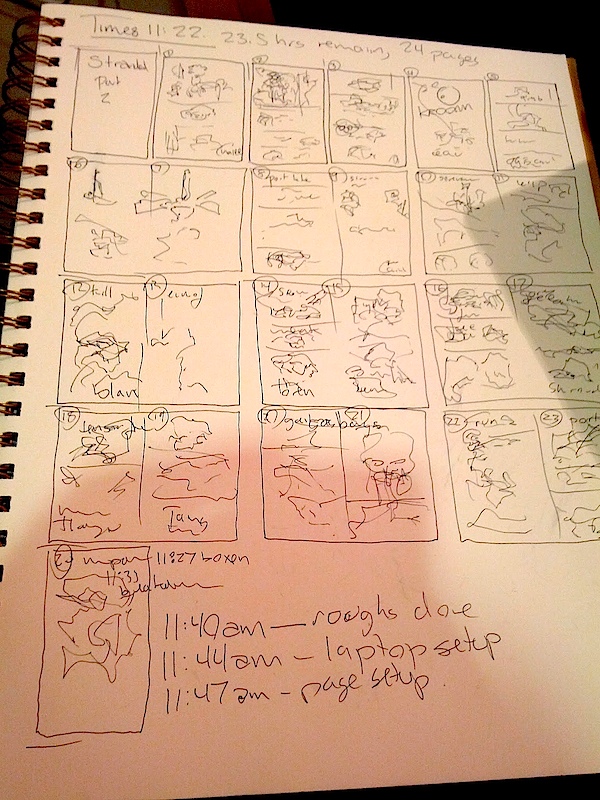
Alright, back to it. All the preliminaries are out of the way: I've got a story, an outline, thumbnails on one art book and an empty art book next to it, a laptop with Internet, art books, art materials, a soda, and a donut. Now: starting the first page!
12:00 NOON START PAGE ONE: Riffing on the two page spread near the end of the previous book, without being too obvious about it if you read it straight through.
12:05PM: Panel borders penciled.
12:15PM: Panel borders inked. Need to improve this process.
12:26PM: Sketching done.
12:46PM: Panel 1 done. Too slow.
1:06PM: Panels 3-4 done. Getting sloppy, messed up space for dialogue. Whiteout marker broken, decide to come back later and fix. (I never did).
1:22PM: Panel 5 done.
1:24PM: Finish ~2 minute break
Total time for Page One: 1 hour, 24 minutes. Way too slow. Need to be around 45 minutes.
Now I know I'm going to be drawing people I've drawn less often, like Norylan below (note: this is a colored sketch from my notebook, NOT from any 24 Hour Comic Day :-). So it's time to break out the laptop.
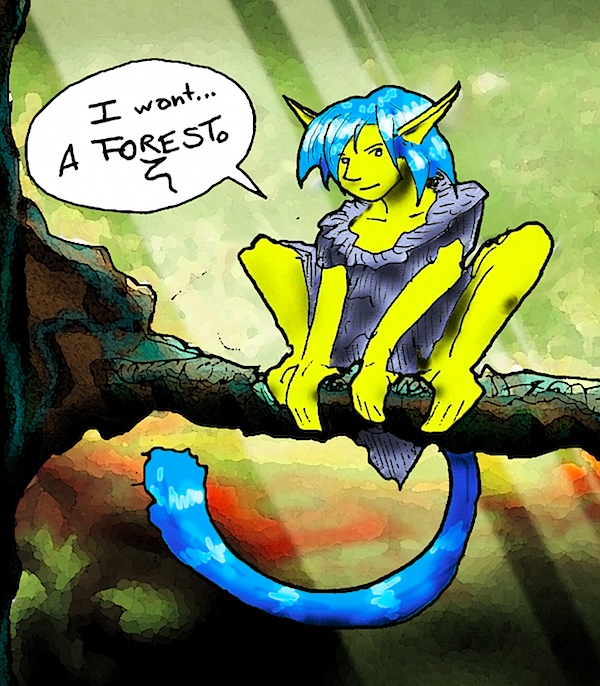
So the laptop setup WAS important after all!
1:24PM START PAGE TWO: The first new page, first appearance of Norylan. I use the laptop to find a "Mug Shots" directory I did for the Serendipity Facebook page, and put up faces of all the characters. My target for this page is 2:15PM.
1:30PM: Finish pencil panel lines.
1:35PM: Finish inked panel lines.
1:49PM: Rough pencils.
2:04PM: Panel 1.
2:17PM: Panel 2.
2:29PM: Panel 3.
2:34PM: ~5 minute break.
Total Time for Page Two: 1 hour, 10 minutes. Still need to streamline. Starting to get worried, even though I know I have two dual page spreads in my layout.
2:34PM START PAGE THREE: Focusing on how to do this easier. Not sure how, but work at it. Target: 3:15pm.
2:38PM: Inked panel borders.
3:00PM: Finish panel 1, after some researching centaur shapes and Norylan poses.
3:15PM: Finish 15 minute interview by reporter for a blog.
3:27PM: Finish page.
Total Time for Page Three: 1 hour, 3 minutes. Things are improving, with the caveat that this is the point I start counting the breaks at the start of the page rather than at the end (because if you get done just before the end and then take a break, who cares?)
3:28PM START PAGE FOUR: Really focusing on how to speed up. Ambition not helping so much.
3:30PM: Finish 2 minute bathroom break.
3:33PM: Finish pencil panel borders. Really wishing I'd made an 8x12 template.
3:38PM: Finish inked panel borders.
3:51PM: Done with Panel 1.
3:55PM: Done with Panel 2. HOW? How did it get done so fast?
4:13PM: Done with Panel 3. WHY? Why did it take so long?
4:25PM: Finished Panel 4.
Total Time for Page Four: 57 minutes. Starting to improve. We might finish if we power through it.
4:25PM START PAGE FIVE: Switched to inside the ship. Maybe this will speed things up. And add context.
4:28PM: Finish ~3 minute break.
4:40PM: Finished ink boxes.
4:48PM: Finished setting up Excel spreadsheet to track progress and see how fast I need to go to finish. I used it up to about the second dual page spread.
5:26PM: Finished page.
Total Time for Page Five: One hour, 1 minute. Argh. Back to slowness. But people seem to like this page.
The following graph shows my progress over the day - spoilers, but you should already know I finished.
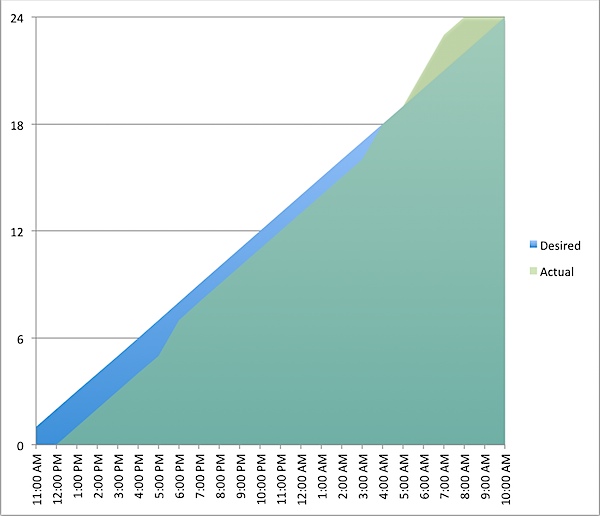
The graph is after the fact; I just used it at the time to figure out that I needed to be doing a page in 54 minutes or less. Back to it!
5:26PM: START PAGES SIX AND SEVEN: A dual page spread at last! Target: 6:15PM.
5:45PM: Finish break.
5:50PM: Finish sketch and borders.
6:26PM: Finish page.
Total Time for Pages Six and Seven: 1 hour. Still slow, but I've made up time by the dual page spread.
6:26PM: START PAGE EIGHT: Back to a page, aware I need to pick up the pace. Can I simplify? Target: 7:15PM.
6:36PM: 10 minute break concludes.
6:46PM: Panels done, plus talking.
7:04PM: Panel 1 done.
7:22PM: Panel 6 done. By a happy coincidence, I had three small horses in my box of art props, in positions ranging from standing to trot to gallop, perfect for panels 5-7.
7:26PM: Panel 7 done.
Total Time for Page Eight: 1 hour. Still not speedy. Argh.
7:26PM: START PAGE NINE: Nuts, poses with people looking up. Argh! Target: 8:15PM.
8:20PM: Done, with a 5 minute break in there.
Total Time for Page Nine: 54 minutes. Still not speedy. Argh. But it's a notch faster than my 56 minute desired time (time has ballooned a bit since I had been falling behind).
Somewhere around this point I really started to flag, to really feel despair and to decide I didn't want to do this, but I pulled out a Panera bread cinnamon roll I'd purchased for just such an occasion and was soon re-energized!

Beans and vinegar, sugar high, go!
8:20PM: START PAGE TEN: A complicated pose, but only two panels, easy, right? Target: 9:05PM.
9:05PM: Finish Panel 1. During this, I had to pose several models on top of each other, hold the models at different angles, tweak the stuff ... oh dear.
9:30PM: Finish Panel 2. Argh! But people seem to really love this shot.
Total Time for Page Ten: 1 hour, 10 minutes. But it's a great page.
9:30PM: START PAGE ELEVEN: An even more complex pose: two characters holding another on a gurney looking down from the top of the ship. Argh! Target: 10:15
9:38PM: Finish break.
9:46PM: Finish panels. Where's that 8x12 template again?
10:20PM: Finish page.
Total Time for Page Eleven: 50 minutes. Getting better.
10:20PM: START PAGE TWELVE: Things going better; I'm on page twelve, I should be on page twelve by my Excel spreadsheet. I decide to skim backgrounds and use silhouettes here to simplify.
10:30PM: Finish ~10min break.
10:51PM: Finish Panel 1. Silhouette of Norylan looks great. Made a slight gaffe overblacking an area, but you can't tell in the finished product.
11:05PM: Finish Panel 2. The blaster design is what I can draw. I'd have done this with 3 panels if I could have.
11:15PM: Finish Panel 3. Norylan!
Total Time for Page Twelve: 55 minutes. Right on time, according to Excel.
11:15PM: START PAGE THIRTEEN: A single page spread, on purpose.
11:54PM: Finish Panel 1. Suprisingly hard to get the design of INDEPENDENCE right, but in the end, the ship looks great and is a great backdrop for the action.
Total time for Page Twelve: 39 minutes. Woo hoo! Getting ahead.
11:54PM: START PAGE FOURTEEN: Even simplified, this will be a bear. 7 panels, one a crowd scene.
12:09AM: Finish ~15 minute break. Isn't it weird that AM and PM designators switch an hour before the clocks roll back from 12 to 1? I guess the easier way to think about it is that since the clock loops around, 12 on the clock really is a funny way of saying 0 (12 mod 12 = 0 :-).
12:15AM: Finish panel boxes.
12:29AM: Finish the surprisingly complex Panel 1 - four characters in a complex pose.
12:32AM: Finish Panel 2.
12:40AM: Finish Panels 3 and 4.
12:59AM: Finish Panel 5 - a night crowd scene around a fire. AAAAA!
1:10AM: Finish Panel 6. Tianyu came out very well as a shadow in the dark.
1:16AM: Finish Panel 7. Ah, done with blacks for now. Next few pages, I cheat.
Total Time for Page Fourteen: One hour, 26 minutes. Argh. Back to the grind.
It's around this time, not sure when precisely, that I had the second incidence of questioning my sanity.
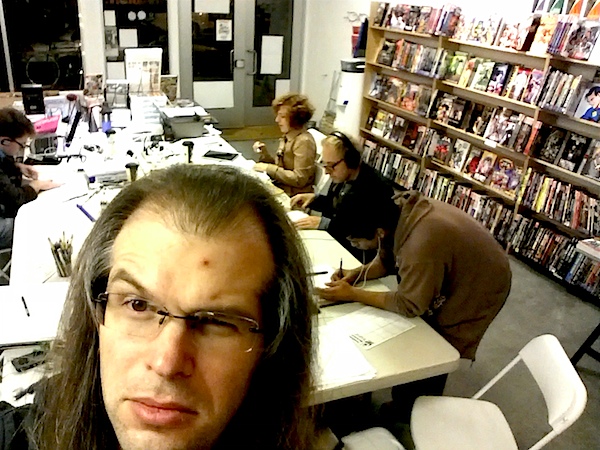
I'd already had dinner from a nearby cafe, and a donut didn't help, so it wasn't food shortage. My memories are a bit jumbled, but I recall taking a brief nap, about 10 minutes, but panels danced before my eyes and I realized my resistance was that I didn't have a good plan for the next few pages. I scanned the panels in my mind, decided, and got up and went back to work.
1:16AM: START PAGE FIFTEEN: Simplify. Eliminate blacks; pretend the campfire illuminates like day.
1:33AM: Finish ~17 minute break. Needed that.
1:37AM: Finish inking panel borders.
1:40AM: Finish panel 1. Not even sure I penciled this one.
1:50AM: Finish panels 2-3. Almost no penciling again: close characters in foreground.
2:12AM: Finish panel 3. Complex characters in interesting pose, more work.
Total Time for Page Fifteen: 56 minutes. Not bad, counting the break.
2:12AM: START PAGE SIXTEEN: A complex pose atop panel 1: a centaur falling on a person. Argh! I put a horse model atop a superhero model and used that. Sadly, you can sort of tell as the person's pose is too stiff.
2:58AM: Finish Panel 3.
Total Time for Page Sixteen: 46 minutes. Not bad. Getting bolder with the no pencils when I can get away with it.
2:58AM: START PAGE SEVENTEEN: I like this page. Romance, kung fu, and death threats!
3:12AM: Finish ~14 minute break.
3:59AM: Finish Panel 3.
Total Time for Page Seventeen: 1 hour, 1 minute. Slower, but complex.
Again, somewhere around here, it isn't clear, I wanted to just give up - for the third time.

This time, it wasn't a sugar low, or a panel problem, or any of those other things. Despite the picture (actually taken earlier in the day; I was too busy to take pictures at this point) I wasn't that tired. I just wanted to quit. I realized there was no external thing I could do to help me. I had to just power through it, just reach in and find the place that said ... continue.
3:59AM: START PAGE EIGHTEEN: Simplify, just keep it going. Took a short break.
4:36AM: Finish Panel 4.
Total Time for Page Eighteen: 37 minutes. How? Amazing.
4:36AM: START PAGE NINETEEN: Simplify, but this is more complex. Avoid pencils?
4:48AM: Break for 12 minutes.
4:55AM: Finish panel borders.
5:02AM: Finish sketch of Panel 1.
5:09AM: Finish Panel 1.
5:36AM: Finish Panel 4.
Total Time for Page Nineteen: 1 hour. Slower, but we're getting close to the end.
5:36AM: START PAGES TWENTY AND TWENTY ONE: A dual page spread, woo woo!
5:37AM: Finish 3 minute break.
6:20AM: Mostly finished.
6:22AM: Finish Panel 1.
Total Time for Pages Twenty and Twenty One: 46 minutes. Not bad for a two page spread!
Now I am officially way ahead. The dual page spread, finished early, has put me 1 whole page ahead of schedule.
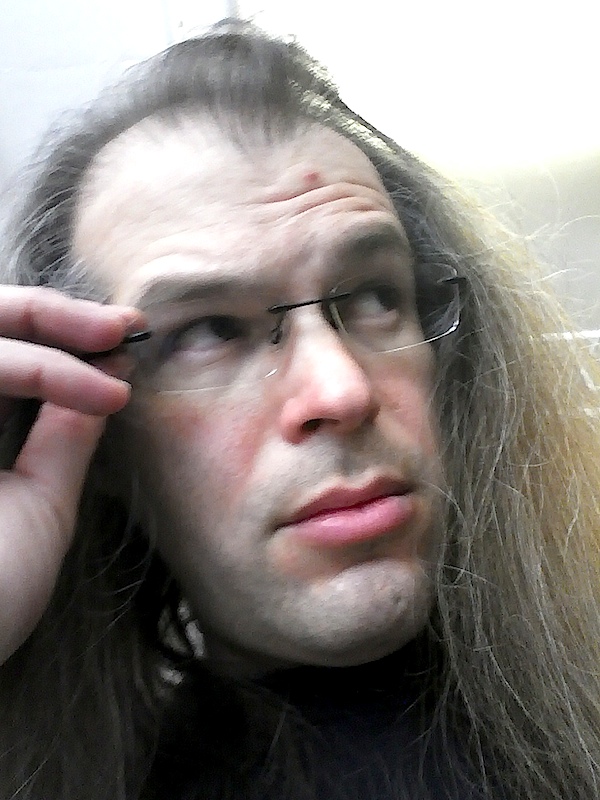
This picture, again taken earlier, represents my now renewed burst of enthusiasm - shoot, still 3 more pages.
6:22AM: START PAGE TWENTY TWO: When I "should" be at page 20. Woot! Goal: 7:10am. This page could be complex, but I'm going to simplify it. Most complex thing: two characters riding a centaur.
7:01AM: Finish Panel 4.
Total Time for Page Twenty-Two: 38 minutes. Woot! Go no pencils, except where hard.
7:01AM: START PAGE TWENTY THREE: When I "should" be at page 21. Woo woo! Simplify even more; drawing a giant door. Yes, I'm ahead, I could get complex, but *F* that at this stage, it's better to be DONE! Hardest part: showing a character falling backwards into water.
7:05AM: Finish inking panel borders.
7:35AM: Finish Panel 3.
Total Time for Page Twenty-Three: 34 minutes. Almost there ... stay on target ...
7:35AM: START PAGE TWENTY FOUR: When I "should" be at page 22. Almost there! One single panel spread!
8:20AM: Finish Panel 1.
Total Time for Page Twenty-Four: 45 minutes? Axually, I don't know. I strongly suspect the 8:20 figure is my "target time" and that I finished slightly early. Still ... it's better to be DONE!
Hey, wait a second ... I FINISHED! Go Team Centaur! Go Blitz Comics! Go Mission Comics! Go 24 Hour Comics Day!
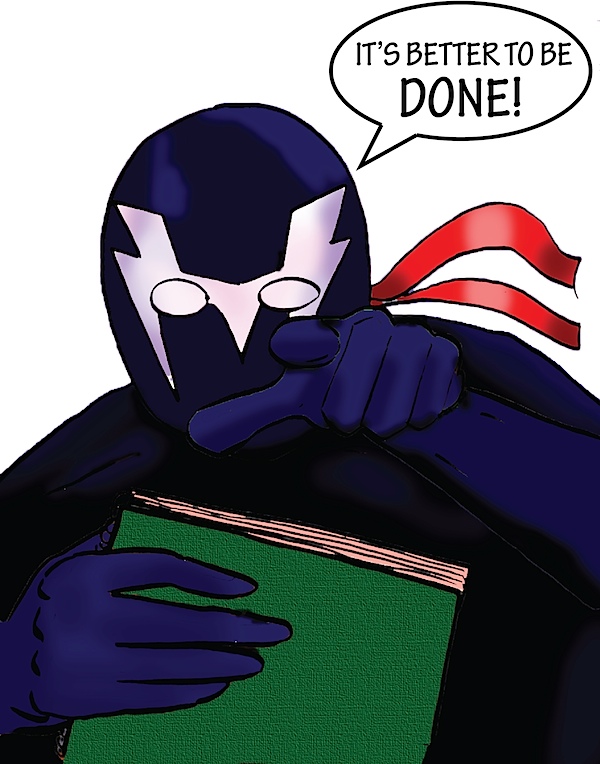
So ... now what? Well, after chilling out a bit, stretching, I hung out with people at the event. People began to finish up around me; a few people had beat me, some by a little, some by a lot - two people finished way early and went back and watercolored all their pages. While I didn't track times, this is how the rest of the day went, more or less:
8:20AM: START CHILLDOWN. O.M.G. I'm done. Don't panic. Don't gloat. Chill out, stretch your wrists, take a walk.
Mostly, I just walked around, talked to people, started cleaning up. Sooner or later, people started cleaning up.
9:00AM: SHOW ME YOURS, I'LL SHOW YOU MINE: People start noticing that others have finished, or people begin announcing it. Some people pass around their comics. At least three of them were watercolored. All were interesting, all were different, and a few had really genuine scares and laughs.
10:00AM: INTERVIEW: The reporter returns and begins interviewing everyone. Each one takes about 10 minutes. It's fun and great to unpack your thoughts.
10:30AM: TEARDOWN: I and Nathan begin packing up. I vow not to take so much next time; I have a good grip on how much I can use in one trip now. Basically, if it doesn't fit in one bag that you can sit next to the desk while you work, you are not going to pull it out.
11:00AM: FAREWELLS: Nathan and I are invited to have breakfast with Doc and Leef, but Nathan's too worn out for this and needs to crash. We decide to bail, say our farewells, and leave Mission Comics to wind our way back the street of trees and dreams.
T-plus 1 hour: THE VOYAGE HOME. Nathan and I are surprisingly alert enough to start a postmortem. We come up with a list of ideas about 24 Hour Comics Day which we're going to turn into a series of blogposts. I'm fading fast, and feel microbursts of sleep as I drive. Not safe. Drop Nathan off, then get breakfast.
T-plus 2 hours: BREAKFAST AND POSTMORTEM. I go to my favorite restaurant, Aqui's in Blossom Valley, and get a spectacular French toast breakfast while I unpack my ideas. I email them to Nathan, capturing our conversation on the drive, then hastily bang together a trip report. A friend is having a baby shower, but I'm simply too exhausted and go home to sleep.
Yes, French toast. That is my reward for a hard day's work. That, and blissful unconsciousness.

But that's not the end of 24 Hour Comics Day, oh no. We need ... the POSTMORTEM! This postmortem, axually.
T-plus 3 hours: NAP Yes, sleep. But not much. I'm too wound up, and wake up.
T-plus 5 hours: UNWIND. I unpack the car, kick around the house, chat with Sandi, and unwind.
T-plus 11 hours: CRASH: After doing as much damage as I can, I crash, hard.
T-plus 23 hours: AWAKEN: Yes, I do indeed wake up at almost 10 the next day. What can I say, I love my job, which cares more about how much work you do than when you get there. I got in to work around 11am, 24 hours after 24 Hour Comic Day ended.
T-plus 2 days: BACK TO SPEED: The first day was rough, but by Tuesday I was back at it and had started writing this postmortem. It took me two whole days.
T-plus 3 days: POSTMORTEM COMPLETE. Complete as of me writing this paragraph. I've got back to speed with my other writing projects (DOORWAYS TO EXTRA TIME and SPECTRAL IRON, *ahem*), scheduled a meeting with Nathan for next Wednesday to plan out the next year of Blitz Comics ... and finished this postmortem.
And that, my friends, is a 24 Hour Comics Day.
-the Centaur
